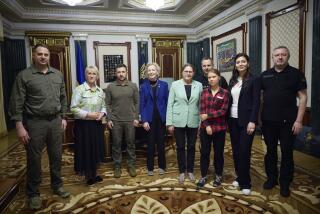Reagan Appoints Task Force to Study Fallout
BALI, Indonesia — President Reagan has appointed an inter-agency task force to monitor the health and environmental hazards of the Soviet nuclear disaster, but there appears to be no danger to the United States at this time, the Administration announced here today.
The radioactive air mass currently is moving over the Soviet Union, but it is too early to predict whether any of it will reach North America, White House spokesman Larry Speakes told a press briefing.
Even if the cloud does reach the United States, it will have been so dissipated by normal atmospheric conditions, Speakes said, that it is “highly unlikely it would pose a public threat.”
EPA Head to Lead Task Force
Reagan appointed the task force, headed by Lee M. Thomas, administrator of the Environmental Protection Agency, while flying aboard Air Force One from Honolulu to Bali for his meetings here with Indonesia President Suharto and the foreign ministers of Indonesia and the five other members of the Assn. of Southeast Asian Nations.
Also on the task force are representatives of the Air Force, Department of Energy, Federal Aviation Administration, Food and Drug Administration, Nuclear Regulatory Commission, State Department, CIA and the National Oceanic and Atmospheric Administration.
The task force will monitor the nuclear fallout on a regular basis, and the EPA will hold daily briefings to keep the American public informed of any dangers, Speakes said.
Reagan said the latest developments on the Soviet nuclear disaster will be disclosed at a joint briefing by the Environmental Protection Agency and Nuclear Regulatory Commission at the State Department today.
White House officials were clearly angry that the Soviet Union withheld information about the accident until it was forced into disclosure by complaints from Scandinavian countries, which had detected increased radiation in the atmosphere.
Speakes said it would be counterproductive to issue a condemnation at this time, but he added that “the U.S. does hope the Soviet Union will live up to its international obligations by providing information in a timely matter.”
Information available to the U.S. government, Speakes said, shows that the fire occurred at the fourth and newest reactor at the Chernobyl plant. It destroyed most of the reactor core, which he said contains 200 tons of uranium and 1,700 tons of graphite.
The fire could continue for days, even weeks, and will spread radiation as long as it burns, he said.
While Administration officials described the nuclear accident as a major catastrophe, Speakes said, “This type of accident could not happen in the U.S.” He explained that the United States has only two graphite reactors of the type used in Soviet nuclear plants and that both have protective safety features--containment buildings and redundant cooling systems--to prevent fires from breaking out.
One of the U.S. graphite plants is an experimental project operated by the Dept. of Energy in Hanford, Wash., Speakes said. The other is the Fort St. Vrain commercial plant in Platteville, Colo.
The exact number of Americans in the Kiev area is not known, Speakes said, but several American students traveling in the Soviet Union are known to be in that area now. “Unfortunately, the Soviet Union hasn’t told us what efforts are being made to protect Americans who are there,” he said.
Reagan has notified Soviet leader Mikhail S. Gorbachev through diplomatic channels that the United States is ready to offer humanitarian and technical assistance. Speakes pointed out, however, that “no one in the world has experience in dealing with this kind of fire.” Asked if the disaster has changed the President’s view toward nuclear power, Speakes said, “It does not.”
Reagan has long been an outspoken advocate of nuclear power as an energy source. Assistant Secretary of State Rozanne L. Ridgway met with Soviet officials in Washington on Tuesday to express the Administration’s “deep regret” and to offer any assistance needed.
More to Read
Sign up for Essential California
The most important California stories and recommendations in your inbox every morning.
You may occasionally receive promotional content from the Los Angeles Times.










